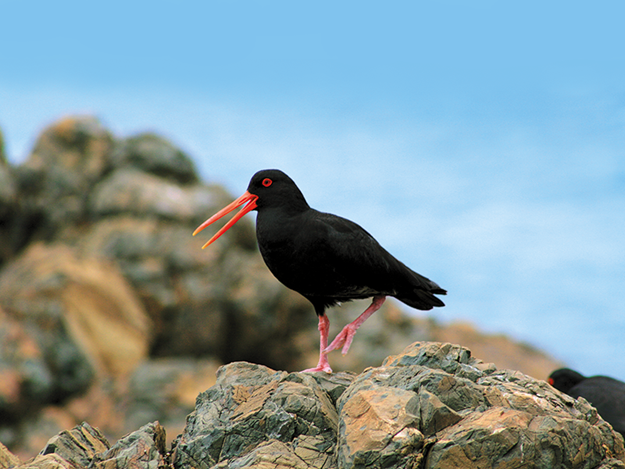 |
|
An oyster catcher |
We were aboard the 9am Fullers ferry from Auckland’s Ferry Terminal to Tiritiri Matangi, a scientific reserve and sanctuary for rare wildlife. It’s situated 30km north-east of Auckland and 4km off Whangaparaoa Peninsula’s coast.
The ferry followed the East Coast Bays coastline passing yellow-ish gold cliffs, homes getting sparser. At 9.50am, we arrived at Gulf Harbour Marina, on Whangaparaoa Peninsula’s tip, to pick up more passengers and around 20 minutes later approached bush-clad Tiritiri Matangi.
Before boarding, I’d cleaned my shoes at the ferry terminal’s boot cleaning station and had my bag sni ed by a brown and white terrier, assumedly seeking rodents. No pests, insects, seeds or dirt are welcome, but we were.
On the island
A trailer awaited the luggage of overnighters staying at the DOC hut, and bags of those who didn’t want to carry them while walking the island, for transporting to the Visitor Centre. A DOC ranger greeted us, giving information about the island and of the guided walks available; 1-1 ½ hours on the Wattle Track or 2 hours on the Kawerau Track, led by volunteers from the conservation group Supporters of Tiritiri Matangi Inc. Mostly in their 60s and 70s, around a dozen were available, so there were around six visitors per leader.We headed north on Hobbs Beach Track coming across little blue penguin nesting boxes, small stone and concrete structures. Wooden lids were lifted to peer through the glass or Perspex covering. Nobody was home.
We walked the pink-tinged sand of Hobbs Beach and saw variegated oyster catchers strutting on skinny orange legs, poking their orange beaks in the low-tide as they searched for crabs and shell sh. Looking down on the sand, between pohutukawa, our guide Manannan told us he’d twice seen Greg, an elderly tuatara who has a burrow somewhere along it. I wish I had.
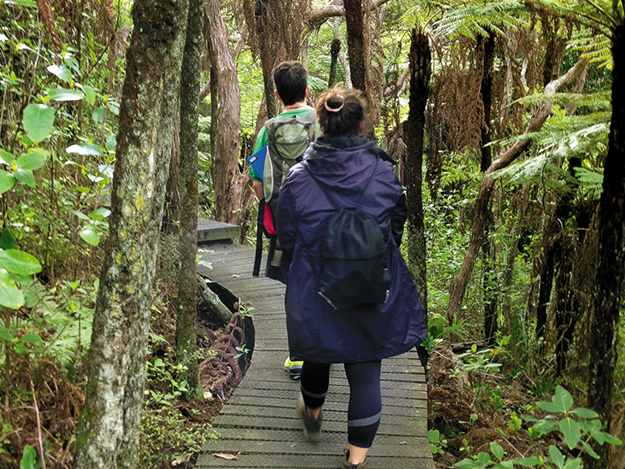 |
|
Walking the Kawerau Track |
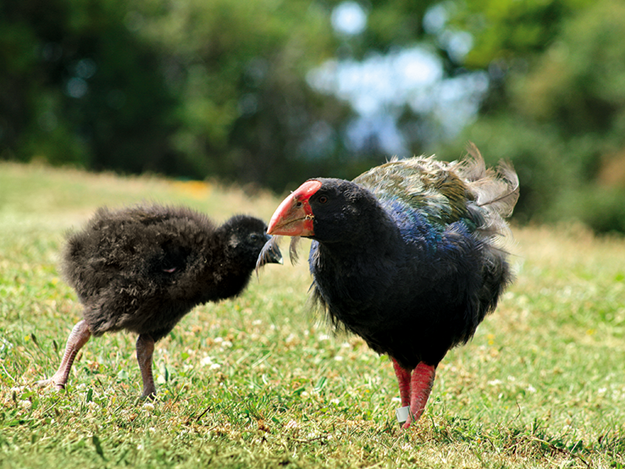 |
|
A takahe feeding its chick |
Tui sang as we traversed the bush; fantail flitted, chasing the bugs kicked up as we walked. The high-pitched twitter of whiteheads, who do have white heads, could also be distinguished. Manannan explained that the call of the rifleman, New Zealand’s smallest bird, is so highpitched that older people can’t hear it. Manannan was about 16 years old; he would certainly hear one if it made an appearance.
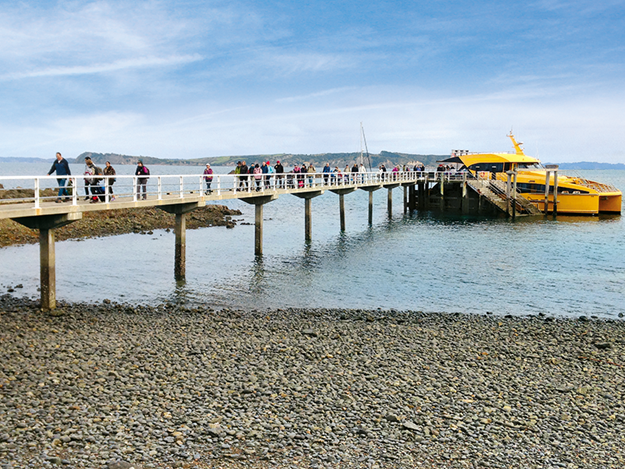 |
|
Arriving at Tiritiri Matangi |
Rare bird sightings
Being the first group to walk the leaflittered track that day we were fortunate enough to see a North Island robin hopping the trail ahead. More exciting was a North Island saddleback. I had never seen one before. Manannan related the Maori legend behind its markings.Lassoing the sun to slow it down, Maui was hot and thirsty. He asked the saddleback to fetch water but it refused. Angrily, Maui grabbed it. His hot hands scorched the bird, leaving it with a rustbrown back.
We walked through North Island kokako territory, an endangered bird with a deep blue wattle, but didn’t see one or hear its ghost-like call. Plump kereru, the second largest bird on the island, sat silently on branches, perhaps over-gorged on red puriri berries. Manannan pointed out a very old puriri tree, pock-marked with large holes bored over the years by puriri moth larvae.
Along the track, among trees such as matipo, cabbage tree, kowhai and totara, signboards informed of plants and insects. I read about wetapunga – the giant weta; karaka leaves used by Maori to cover wounds; flax notch caterpillars that chew notches in flax; giant centipedes; and Northern tuatara.
We peer into weta hotels; wooden structures perhaps 30cm long and 10cm wide with rectangular ‘rooms’ attached to the sides of trees. Behind the door, keeping rooms dark, a glass frontage gave views of several 1.5cm long cockroaches, but wetapunga weren’t in.
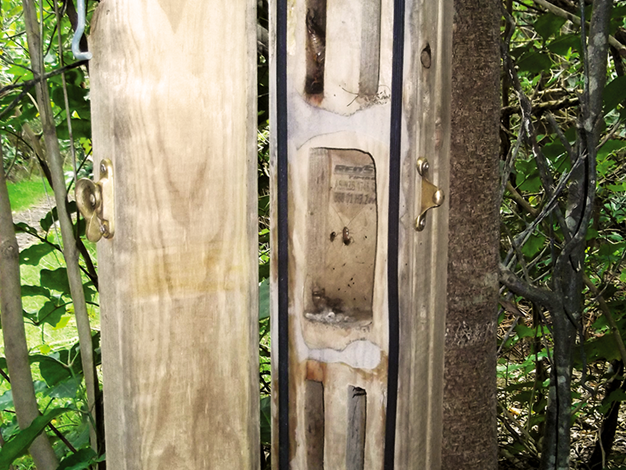 |
|
A weta hotel |
Occasional bird feeders, cages containing large receptacles of sugar water provided by Chelsea Sugar, were busy with darting hihi (stitchbird) and korimako (bellbird). Built to keep large birds out, the feeders were intended for the rare hihi, a nectar-lover. When there aren’t enough plants in flower, the feeders supplement its food, which in turn helps produce more chicks.
The area was a symphony of birdsong; high-pitched, hollow-sounding, short bursts and the long melodies of the korimako – which Manannan described as an opera singer. The male hihi was easily identifiable with bright yellowyorange feathers across its lower neck and shoulders; the male korimako, olive green with a purplish head.
We passed by a pohutukawa thought to be over 800 years old. Its limbs wandered, twisting and turning for perhaps 50 metres, giving the appearance of several trees, not one. However, because of a lack of old hollow trees for birds to nest in, nesting boxes are made available. These make it easier to monitor bird numbers when counts are made of chicks during breeding season. Also seen were traps on the ground, more numerous along the coastline, and set when stoat or rat prints are found on monitoring cards inside tracking tunnels.
We emerged from Kawerau Track onto gravelled Ridge Road, which runs the island’s length, then walked Cable Track. Five fantails flitted like butterflies before us as we neared an open rise giving views of Kawau, Little Barrier, Great Barrier and Coromandel Peninsula. To the right of these was the 1864-built, 20.5-metre white lighthouse on the island’s southern end. Back on Ridge Road, it was a short walk to the Visitor Centre.
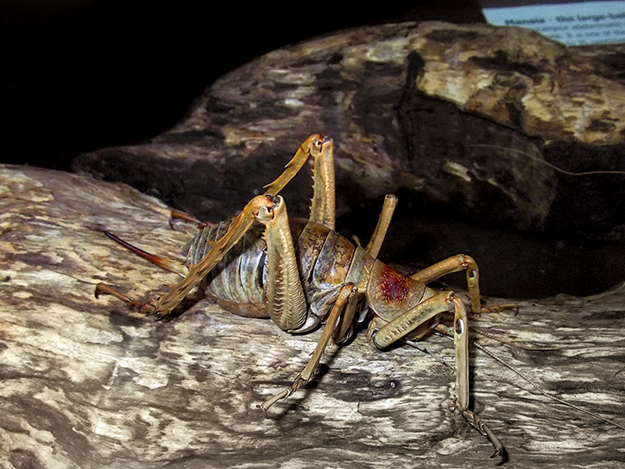 |
|
A wetapunga, albeit dead |
The Visitor Centre
Outside the centre, sugar feeders were crowded with glossy tui, their hair-like white plumage surrounding their necks, and wings and tail of emerald and teal beneath a cloak of brown feathers. Beautiful.The Visitor Centre’s shop is stocked with bird-themed items – among them books, plaques, leadlight hangings, posters, finger puppets and tea towels. Food is unavailable on the island but complimentary tea and coffee are. The Education Centre has displays on the island’s history, birds and insects. I saw a wetapunga, albeit dead.
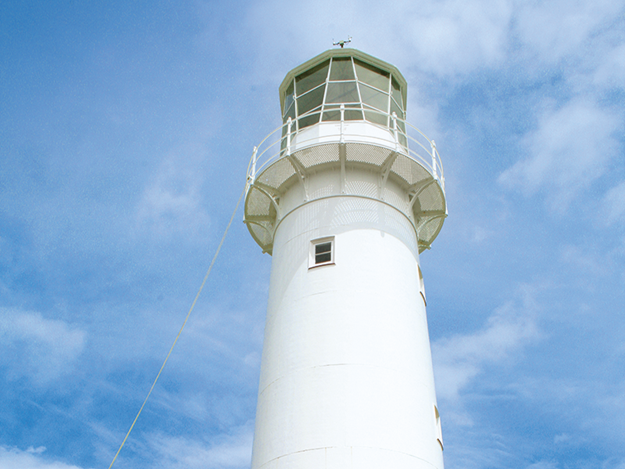 |
|
Tiritiri’s lighthouse |
The old watchtower, like a lifeguard station, still stands. The various features on the landscape, with distant shadows of land and islands, ink blots in a grey sea, are identified by a signboard – Waiheke, the Noises, Hunua Ranges, Rakino, Beachlands, Motutapu and Rangitoto.
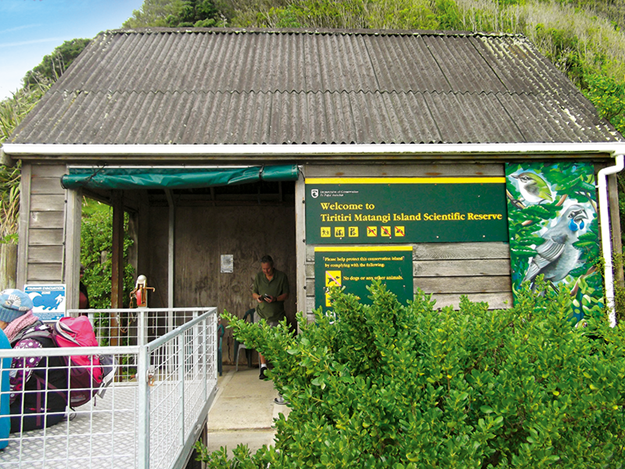 |
|
Welcome to Tiritiri Matangi |
Walking the East Coast Track
We briskly walked the East Coast Track, mostly through bush with few people and fewer birds. We looked down on rocky coastline – sandy Fisherman Bay scattered with driftwood along its high tide mark, and Pohutukawa Cove, where turquoise water lapped between narrow gapped rocks. Along North East Bay Track, leading to the island’s tip, is a wetlands area where, if we’d taken more time, we’d perhaps have seen a brown teal among the flax, cabbage trees and white-flowered kanuka… or manuka. Yellow-flowered gorse broke the greenness; an occasional sweet smell reminded me of honey.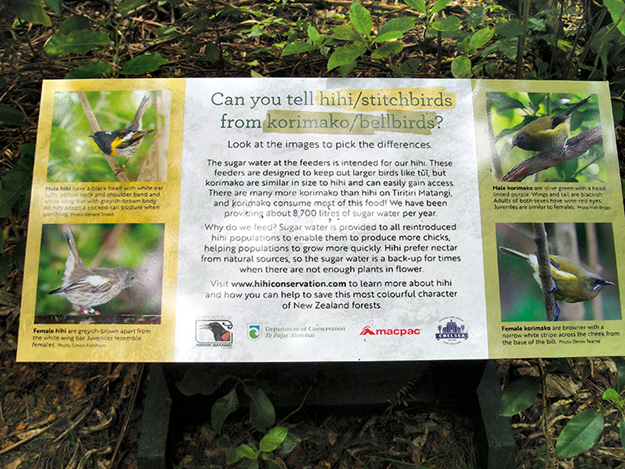 |
|
The difference between hihi and korimako |
After a walk of more than one-and-a-half hours from the lighthouse, we reached the wharf in time for the 3.30pm sailing, leaving the melodious island for the cacophony of the city.
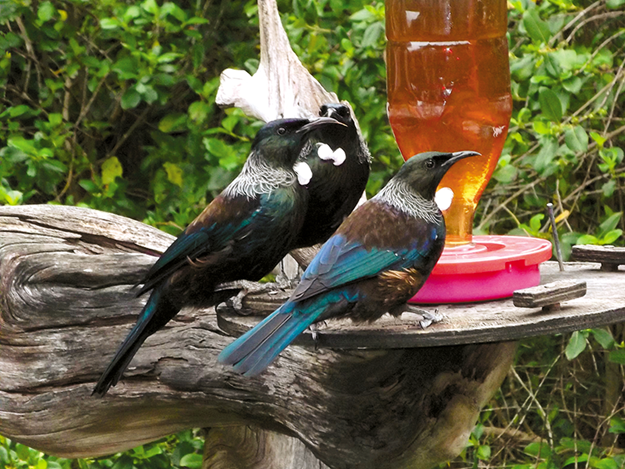 |
|
Tui feeding outside the Visitor Centre |
Getting there
To book a Fullers Ferry from downtown Auckland and Gulf Harbour, and guided walks, visit fullers.co.nz.Where to stay
To do a nightwalk and perhaps see little spotted kiwi, little blue penguins and tuatara, overnight in the island’s DOC hut. Visit doc.govt.nzStillwater Motor Camp at 2 Duck Creek Road, Stillwater – 35 minutes from Gulf Harbour. Visit nzmca.org.nz/travel/directory/view/235
Campervan sites are available at Shakespear Regional Park, which is just a 10-minute/6km drive from Gulf Harbour Marina. Visit aucklandcouncil.govt.nz/parks-recreation
Freedom camping is available in Gulf Harbour Marina’s carpark, 1311 Laurie Southwick Parade, Gulf Harbour, Whangaparaoa. Visit nzmca.org.nz/travel/directory/view/234
Volunteer
For information on becoming a supporter of Tiritiri Matangi, a volunteer guide, or help with maintenance, visit tiritirimatangi.org.nz/get-involvedFind motorhomes, caravans and RVs for sale in NZ





